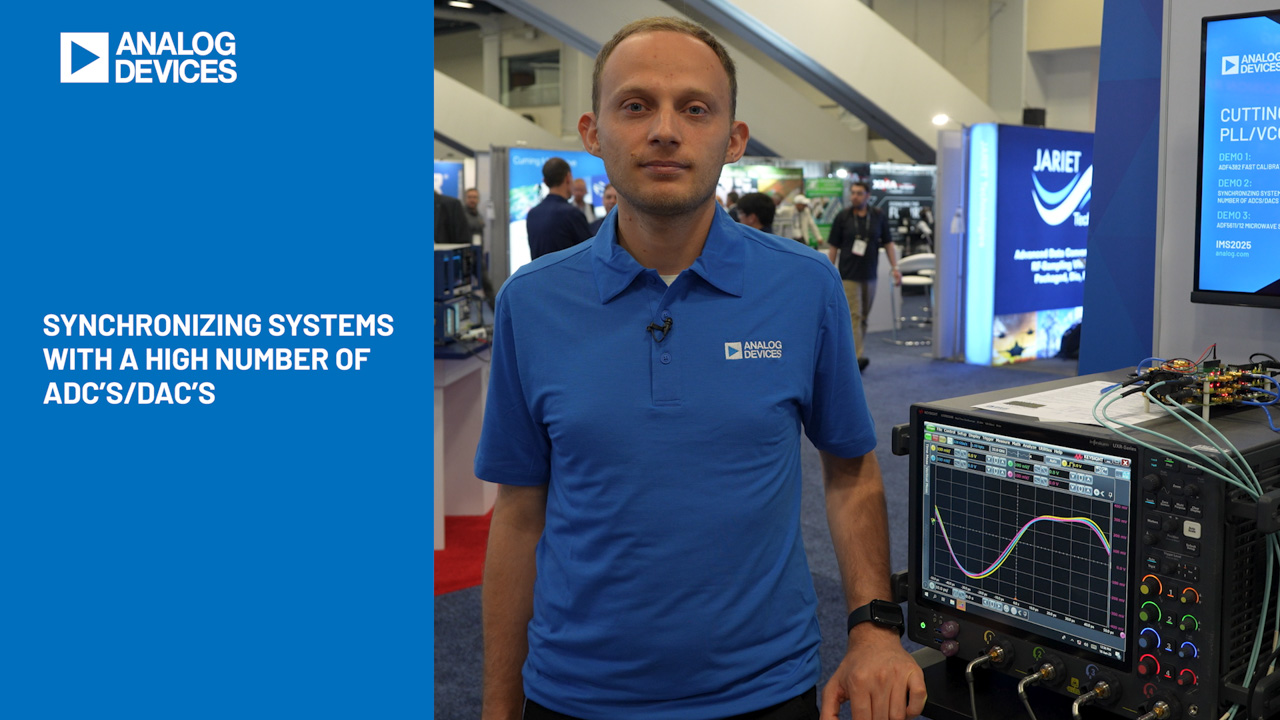面向大电流、快速瞬态响应噪声敏感型应用的多相解决方案—第2部分:耦合电感
阅读本系列的其他文章。
摘要
“面向大电流、快速瞬态响应噪声敏感型应用的多相解决方案——第1部分”一文重点介绍了ADI公司Silent Switcher 3技术在多相单芯片降压稳压器中具有的高控制环路带宽。从单相设计转变为多相设计时,可以观察到在瞬态事件过程中,恢复时间大幅缩短,输出电压峰峰值偏差也显著减小。在本文中,耦合电感(CL)被融入到多相 Silent Switcher® 3单芯片降压稳压器的设计中,从而将环路带宽提升至500 kHz以上,并将输出纹波降低到峰峰值1 mV以下。文中还探讨了高环路带宽对低频输出噪声的抑制作用。本文还展示了一个医疗成像应用案例,用以比较耦合电感(CL)和传统分立电感(DL)对多相性能的影响。
利用CL扩展多相功能
多相交错式降压转换器常应用于服务器和有线通信领域,因为它们能够高效处理大负载电流,并提供较高的控制环路带宽。然而,多相交错式降压转换器存在一个限制条件,即在稳态运行和瞬态事件期间,相电感的性能表现需求有所不同。为了实现更高的效率,人们倾向于采用高电感值来限制电流纹波,并将开关损耗降至最低。另一方面,为了对瞬态事件做出更快的响应,低电感值可使电源的电荷迅速到达负载,从而使输出电压的下降幅度更小。使用尺寸更小的磁性元件可以减少存储在相电感中的多余电荷,并且在负载移除时降低输出电压的任何过冲现象。这种在效率和瞬态响应之间的权衡凸显了CL为多相设计带来的优势。
耦合电感(CL)可以被看作是一种特殊类型的变压器,它主要通过磁耦合来影响其他绕组的性能表现。在多相配置中,使用分立电感(DL)时,交错的开关信号仅能降低输出节点处的纹波。相比之下,CL会将这种效应传播到所有已连接相的MOSFET和电感绕组上。当某一相被激活时,磁耦合会在其他耦合相内感应出电流的上升斜坡,且这些相的占空比不会发生变化。这意味着电感电流在其所在相的关断时间内不会呈线性下降,而且当其他相激活时,电流又会开始上升。因此,CL可以采用较低的相电感值,同时仍能使每一相产生极小的电流纹波,从而实现快速的瞬态响应和较高的效率。相电感值的降低使得在瞬态事件期间的电摆率更快,并且在不牺牲稳定性的前提下,能够将控制带宽提升到更高的水平。
分立电感与耦合电感之间的控制环路及瞬态响应比较
医疗成像系统通常由大量数据采集电路和DSP/ASIC组成。CT扫描机等大型成像系统的电源既需要快速的瞬态响应,又需要低输出噪声,以实现最小的信号失真和高图像精度。以一个典型的CT扫描探测器模块电源为例,它需要从12 VIN输入电压获得1 VOUT 输出电压和80 A满载电流。ADI的LT8627SP是Silent Switcher 3单芯片降压稳压器系列的一款产品,可提供高达16 A的电流,并具有超低噪声基准,可实现出色的低频噪声性能。使用一个六相LT8627SP可以满足应用对高达96 A负载的需求。各相以2 MHz的开关频率交错工作,从而产生组合的12 MHz输出纹波频率。输出电容由28个22μF 1206 MLCC电容器和2个560μF聚合物钽固体电容器(POSCAP)组成。为了解CL相较于更传统的DL的性能表现,在保持工作条件和输出电容不变的情况下,单独研究不同电感类型对稳压器性能的影响。
市售的两相和三相CL可用于六相LT8627SP配置中,采用3组两相和2组三相的设置均可。在本次研究中,选择了两种具有不同相电感的Eaton CL。两相CL选项包括Eaton CL1206-2-R120(120 nH)和CL0806- 2-R050(50 nH)。测试的三相CL是Eaton CL0806-3-R050(50 nH)。为了给CL的性能比较提供一个基准,将Coilcraft XGL5050-161用作DL性能的参考,因为它的标称电感为160 nH,与两相120 nH CL(CL1206-2-R120)相近,并且它的尺寸外形与所选CL的尺寸外形也相似。
| 分立电感 | 耦合电感 | |||
| 制造厂商 | Coilcraft | Eaton | ||
| 电感 | XGL5050-161 | CL1206-2-R120 | CL0806-2-R050 | CL0806-3-R050 |
| Lk1 | 160 nH | 120 nH | 50 nH | 50 nH |
| Lm2 | - | 130 nH | 120 nH | 120 nH/130 nH |
| ISAT (下降 20%) | 23.5 A | 49 A | 70 A | 70 A |
| DCR | 1.20 mΩ | 0.40 mΩ | 0.25 mΩ | 0.25 mΩ |
| 1CL漏电感,相当于DL相电感 2 CL励磁电感。漏电感与励磁电感的比值决定了耦合系数。 |
||||
在对每种电感进行实验时,对补偿网络进行了优化,以便在尽可能提高环路带宽的同时,实现至少60°的相位裕度和8 dB的增益裕度。当使用CL0806-3-R050电感时,经过补偿调整,实现了最高520 kHz的带宽,同时具有60°的相位裕度和9 dB的增益裕度。
图1显示了波特图的结果,并进行了分组,以便逐步比较。结果表明,当系统增加耦合相数或Ncp时,即使相电感相同(XGL5050-161与CL1206-2-R120相比),环路带宽也可以被推得更高。此外, 当减小相电感并保持Ncp恒定时(CL1206-2-R120与CL0806-2-R050相比),环路带宽会得到扩展。
图1. 使用两种不同电感的波特图比较:(a) DL 160 nH对比两相CL 120 nH;(b) 两相CL 120 nH对比两相CL 50 nH;(c)两相CL 50 nH对比三相CL 50 nH。
为了分析六相LT8627SP在大电流下的快速瞬态响应能力,施加了一个负载阶跃变化为50%且摆率高达40 A/µs的严苛负载变化。如图2所示,根据观察,输出电压在负载阶跃变化完成的同时就开始恢复。在出现这种偏差后的一微秒内,所有输出电压都稳定下来,体现了LT8627SP对变化做出快速响应的出色能力。结果还呈现出一致的规律:随着系统响应速度(带宽)的提高,输出电压的变化幅度会减小。使用LT8627SP的完整六相96 A电路原理图如图5所示。
图2. 使用不同电感时,六相LT8627SP在40 A/1 μs负载阶跃下的上升沿和下降沿瞬态响应
分立电感和耦合电感的稳态输出纹波比较
虽然更高的环路带宽可以减少瞬态事件期间的输出偏差,但稳态(SS)输出纹波同时受到总峰峰值电流纹波和输出电容量的影响。使用耦合电感(CL)的优势在于,与具有等效相电感的分立电感(DL)相比,CL能够产生更小的各相电流纹波。然而,在输出端的各相电流纹波总和,使得CL和DL的总峰峰值电流纹波相同,从而导致总峰峰值输出电压纹波也相近。表2对六相LT8627SP的SS输出纹波测量结果进行了总结,每种电感都采用了经过优化的补偿措施。对于使用XGL5050-160和CL1206-2-R120的设计,其输出纹波约为峰峰值1 mV,这证实了上述想法,因为它们的相电感相似。然而,对于采用两相和三相50 nH CL的设计,测量到的输出纹波却与这一原理相悖,从峰峰值1.33 mV增加到了峰峰值2.10 mV。这令人感到意外,因为原本预期在相电感相同的情况下,总输出纹波也会保持一致。
| L | 控制带宽 | 瞬态 ∆Vout_ppk |
SS ∆Vout_ppk |
| XGL5050-160 | 367 kHz | 118 mV | 1.06 mV |
| CL1206-2-R120 | 421 kHz | 91.4 mV | 0.95 mV |
| CL0806-2-R050 | 509 kHz | 79.0 mV | 1.33 mV |
| CL0806-3-R050 | 520 kHz | 76.6 mV | 2.10 mV |
CL的磁耦合能够在不改变各相占空比的情况下,使其他耦合相的电流上升。这实际上会在输出端引入频率等同于 fsw × Ncp的纹波谐波。峰峰值电压纹波越大,表明随着开关谐波的增加,陶瓷输出电容在分流纹波噪声方面的效果变差。由于封装中存在寄生电感和电阻(ESL和ESR),实际的电容表现得就像一个串联的RLC子电路。这使得电容在不同频率下呈现出不同的阻抗特性。设计中使用的一个22 μF 1206多层陶瓷电容器(MLCC)的阻抗 与频率曲线显示,从1 MHz开始,电容开始表现出更多的电感特性,阻抗也随之升高。因此,期望在从两相CL转向三相CL时,输出纹波水平保持相似是不现实的,因为稳态下的输出纹波会受到输出电容特性变化的影响。
图3. 旁路模式下非理想MLCC和3T电容器的模型。其中给出了六相LT8627SP中所用的22 μF电容器的阻抗与频率特性,以显示阻抗差异。
在不增加解决方案尺寸的前提下,降低输出纹波的一种方法是使用三端(3T)电容器,这种电容器的特点是在宽频带内具有低ESL和大电容。一个22 μF 3T电容器的阻抗曲线显示,与MLCC的情况类似,从4 MHz到6 MHz(由于两相和三相耦合产生的特定开关谐波)存在阻抗增加的问题。因此,用三相CL替换两相CL时,输出纹波预计仍会增加。不过,与传统陶瓷电容器相比,3T电容器在高频下的阻抗要小一个数量级,并且产生的纹波也较小。如图4所示,在将2个22 μF 1206 MLCC更换为2个22 μF 05035 3T电容器后,出现了显著的改善,输出纹波从峰峰值2.10 mV降低到峰峰值0.81 mV。为了有效地使用3T电容器,将它们放置在CL之后最近的位置,以尽量减小寄生电感。具体细节可参考图6。在分立电容相同的情况下,这一结果使得3T电容器的应用极具吸引力。整体设计中电容器的数量和输出电容保持不变,但因输出纹波更小而获益良多。
图4. 使用常见的MLCC电容器与具有相同分立22 μF电容的3T电容器进行的稳态输出纹波比较。测量是基于使用三相CL0806-3-R050电感器的六相LT8627SP进行的。
图5. 六相LT8627SP的原理图,适用于12 VIN、1VOUT、每相2 MHz fsw、96 A负载解决方案。

图6. 多相布局示例。绿线表示单个通道从输入到输出的交流电流路径。黄色标记显示了引至IC相连反馈引脚的本地检测反馈的位置。蓝色框突出显示了每个通道的补偿网络,该连接到蓝色标记所在的内层。
单相和多相LT8627SP的宽带输出噪声比较
尽管很少被提及,但更高的环路带宽所带来的一个显著优势是能够降低输出噪声。Silent Switcher 3超低噪声架构具有出色的宽带噪声性能(通常为10 Hz至100 kHz范围内均方根噪声为4 μV rms),宽带噪声性能已成为噪声敏感型应用的关键性能指标。通常所说的噪声是由稳压器快速开关转换产生的随机幅度残余信号。因此,环路带宽越高,整体输出噪声就越低,因为在更宽的频率范围内能够保持较高的直流增益,从而校正任何残余的稳态输出误差或噪声。如图7所示,更高的环路带宽能够在更宽的频率范围内(直至控制环路交叉频率)衰减低频噪声,从而显著改善整体输出噪声。单相和四相LT8627SP解决方案的噪声曲线基于本系列文章第1部分中介绍的设计,而六相LT8627SP的噪声曲线则是使用六相设计(采用三相50 nH CL、实现了520 kHz带宽)测量得到的。
图7. 单相和多相LT8627SP解决方案的输出噪声频谱密度比较,结果表明输 出噪声随着环路带宽的增加而降低。
采用CL的多相LT8627SP的设计考虑因素与指导原则
下方列出了使用ADI的LT8627SP进行设计时需要考虑的一些关键因素:
- 在使用两相和三相CL时,需要采用不同的交错方案,以便最大限度地发挥CL降低纹波的优势。对于两相CL而言,耦合相的开关信号交错间隔为180°,而使用三相CL时耦合相的开关延迟为120°。耦合相之间的最佳相位延迟的通用公式为 360°/Ncp。
- 在使用CL时,要想对稳态输出纹波进行一致的测量,就需要使用低剖面的探测端子,比如U.FL插座,以避免拾取未屏蔽的耦合电感所发出的噪声。正如本文所讨论的,使用U.FL端子探测输出纹波能得到近乎理想的电压纹波。
- 对于多相单芯片开关稳压器而言,测量其波特图可能是一项颇具挑战性的任务,因为每个稳压器IC都有其自身的反馈和控制逻辑。为确保多相设计能够做出一致的响应,所有IC的OUTS引脚和VC引脚都应按照原理图所示连接在一起。这种精心的布线设计旨在确保,通过任何一个反馈电阻注入的信号,都会在所有单独的控制环路中产生相同的扰动。由于所有相位共享同一个补偿网络,因此所有相位的控制环路都会被迫协同响应。关于多相布局的指南,请参考图6。
结论
CL在融入ADI的多相Silent Switcher 3架构电源转换器后,性能得到了极大提升。这种设计显著增强了转换器应对快速大电流变化的能力,同时大幅降低了输出噪声。多相Silent Switcher 3开关稳压器能够处理超过500 kHz环路带宽的动态负载,并对低频输出噪声进行持续抑制,因而成为了无线通信、工业环境、防务系统、医疗技术等应用领域的有效解决方案。随着新一代开关稳压器的工作频率超过一兆赫兹,传统陶瓷电容器已成为进一步降低输出纹波的瓶颈。为了在更高频率下实现更小的输出纹波,需要具备更低阻抗特性的电容器,比如三端(3T)电容器。通过将CL与低阻抗输出电容器相结合,就能打造出一款响应迅速且纹波低的开关稳压器,多相Silent Switcher 3开关稳压器便是这一设计理念的有力例证。


























